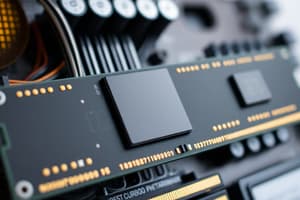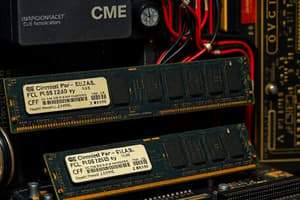Podcast
Questions and Answers
What is the primary function of the Central Processing Unit (CPU) in a computer?
What is the primary function of the Central Processing Unit (CPU) in a computer?
- Stores data permanently
- Facilitates network connections
- Acts as the brain of the computer (correct)
- Converts electrical power
Which type of memory is volatile and loses its data when power is turned off?
Which type of memory is volatile and loses its data when power is turned off?
- Read-Only Memory (ROM)
- Random Access Memory (RAM) (correct)
- Solid State Drive (SSD)
- Hard Disk Drive (HDD)
Which storage device is known for its faster access times and durability compared to others?
Which storage device is known for its faster access times and durability compared to others?
- Hard Disk Drive (HDD)
- Solid State Drive (SSD) (correct)
- Optical Drive
- Magnetic Tape Drive
What component connects all other hardware components inside a computer?
What component connects all other hardware components inside a computer?
What is the primary role of input devices in a computer system?
What is the primary role of input devices in a computer system?
Which device is used for rendering images and video in a computer?
Which device is used for rendering images and video in a computer?
What is the main function of a power supply unit (PSU) in a computer?
What is the main function of a power supply unit (PSU) in a computer?
Which of the following is considered a networking hardware component?
Which of the following is considered a networking hardware component?
Flashcards are hidden until you start studying
Study Notes
Overview of Computer Hardware
- Physical components of a computer system.
- Essential for the functioning of software applications.
Main Categories of Computer Hardware
-
Central Processing Unit (CPU)
- Acts as the brain of the computer.
- Executes instructions and processes data.
- Measured in GHz, indicating speed.
-
Memory
- Random Access Memory (RAM)
- Temporary storage for data and applications in use.
- Volatile memory; loses data when power is off.
- Read-Only Memory (ROM)
- Permanent storage for firmware.
- Non-volatile memory; retains data without power.
- Random Access Memory (RAM)
-
Storage Devices
- Hard Disk Drive (HDD)
- Magnetic storage; larger capacity, slower speed.
- Solid State Drive (SSD)
- Flash memory; faster access times, more durable.
- Optical Drives
- Reads and writes data from optical discs (e.g., DVDs, CDs).
- Hard Disk Drive (HDD)
-
Motherboard
- Main circuit board; connects all hardware components.
- Houses the CPU, RAM, and expansion slots.
-
Power Supply Unit (PSU)
- Converts electrical power from an outlet to usable power for the computer.
- Supplies power to the motherboard and other components.
-
Input Devices
- Allows user interaction with the computer.
- Examples: keyboard, mouse, touchscreen.
-
Output Devices
- Displays or outputs information from the computer.
- Examples: monitor, printer, speakers.
-
Graphics Processing Unit (GPU)
- Specialized processor for rendering images and video.
- Important for gaming, graphic design, and video editing.
Peripheral Devices
- External devices connected to the computer.
- Examples include printers, scanners, external drives.
Networking Hardware
- Devices that facilitate network connections.
- Examples: routers, switches, modems.
Cooling Systems
- Essential for preventing overheating.
- Types include fans, heat sinks, and liquid cooling systems.
Summary
- Computer hardware includes all tangible components necessary for a computer to function.
- Each component has a specific role, contributing to overall performance and capability.
Overview of Computer Hardware
- Comprises physical components essential for a computer system's functionality.
- Supports the operation of software applications.
Main Categories of Computer Hardware
-
Central Processing Unit (CPU)
- Serves as the computer's brain.
- Processes data and executes instructions.
- Performance measured in GHz, reflecting its speed.
-
Memory
- Random Access Memory (RAM)
- Temporary storage for data and currently used applications.
- Volatile; loses data when power is turned off.
- Read-Only Memory (ROM)
- Permanent storage for essential firmware.
- Non-volatile; retains data even without power.
- Random Access Memory (RAM)
-
Storage Devices
- Hard Disk Drive (HDD)
- Utilizes magnetic storage; offers larger capacity but slower speeds.
- Solid State Drive (SSD)
- Employs flash memory; provides faster access times and greater durability.
- Optical Drives
- Reads and writes data using optical discs like DVDs and CDs.
- Hard Disk Drive (HDD)
-
Motherboard
- The primary circuit board connecting all hardware parts.
- Houses the CPU, RAM, and expansion slots for additional components.
-
Power Supply Unit (PSU)
- Converts wall outlet electricity to usable power for the computer.
- Distributes power to motherboard and other hardware.
-
Input Devices
- Allow users to interact with the computer.
- Common examples include keyboards, mice, and touchscreens.
-
Output Devices
- Output information processed by the computer.
- Examples include monitors, printers, and speakers.
-
Graphics Processing Unit (GPU)
- Specialized for rendering images and video.
- Crucial for graphics-intensive tasks like gaming and video editing.
Peripheral Devices
- External devices that can be connected to the computer.
- Include printers, scanners, and external storage drives.
Networking Hardware
- Devices that facilitate internet and network connections.
- Common examples are routers, switches, and modems.
Cooling Systems
- Vital for maintaining optimal operating temperatures and preventing overheating.
- Types include fans, heat sinks, and liquid cooling systems.
Summary
- Encompasses all tangible components required for computer operation.
- Each hardware component plays a distinct role, contributing to overall system performance and capability.
Studying That Suits You
Use AI to generate personalized quizzes and flashcards to suit your learning preferences.



